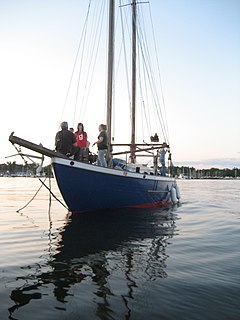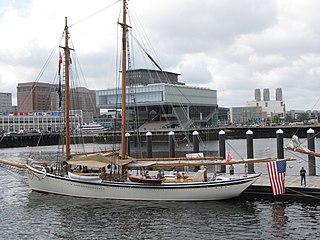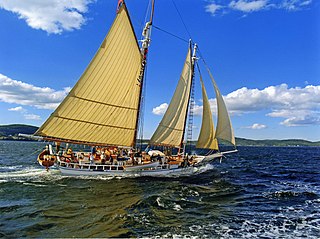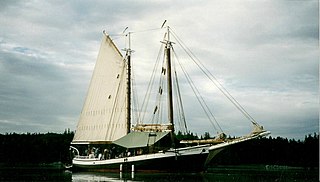
Camden is a resort town in Knox County, Maine, United States. The population was 5,232 at the 2020 census. The population of the town more than triples during the summer months, due to tourists and summer residents. Camden is a summer colony in the Mid-Coast region of Maine. Similar to Bar Harbor, Nantucket and North Haven, Camden is well known for its summer community of wealthy Northeasterners, mostly from Boston, New York and Philadelphia.

The tall ship Elissa is a three-masted barque. She is based in Galveston, Texas, and is one of the oldest ships sailing today. Launched in 1877, she is now a museum ship at the Texas Seaport Museum. She was designated a National Historic Landmark in 1990.

Zodiac is a two-masted schooner designed by William H. Hand, Jr. for Robert Wood Johnson and J. Seward Johnson, heirs to the Johnson & Johnson pharmaceuticals fortune. Hand intended to epitomize the best features of the American fishing schooner. The 160-foot-long (49 m), 145-ton vessel competed in transatlantic races. In 1931 the vessel was purchased by the San Francisco Bar Pilots Association, brought from the Atlantic, modified and placed in service as the pilot vessel California serving as such until retired in 1972.

The S.S.S.Lotus is a historic gaff rigged schooner. Her home port is Sodus Bay in Wayne County, New York. She is owned and operated by the "Friends of the Schooner Lotus."

The schooner J. & E. Riggin, a National Historic Landmark, was built on the Maurice River in Dorchester, New Jersey in 1927. She is one of a small number of surviving two-masted schooners, once one of the most common sailing ships in North American waters. Now based in Rockland, Maine, she serves as a "windjammer" offering sailing cruises to tourists.

Adventure is a gaff rigged knockabout schooner. She was built in Essex, Massachusetts, USA, and launched in 1926 to work the Grand Banks fishing grounds out of Gloucester. She is one of only two surviving knockabout fishing schooners – ships designed without bowsprits for the safety of her crew.

L. A. Dunton is a National Historic Landmark fishing schooner and museum exhibit located at the Mystic Seaport Museum in Mystic, Connecticut. Built in 1921, she is one of three remaining vessels afloat of this type, which was once the most common sail-powered fishing vessel sailing from New England ports. In service in New England waters until the 1930s and Newfoundland into the 1950s. After a brief period as a cargo ship, she was acquired by the museum and restored to her original condition.

The American Eagle, originally Andrew and Rosalie, is a two-masted schooner serving the tourist trade out of Rockland, Maine. Launched in 1930 at Gloucester, Massachusetts, she was the last auxiliary schooner to be built in that port, and one of Gloucester's last sail-powered fishing vessels. A National Historic Landmark, she is also the oldest known surviving vessel of the type, which was supplanted not long afterward by modern trawlers.

Grace Bailey, also known for many years as Mattie, is a two-masted schooner whose home port is Camden Harbor, Camden, Maine. Built in 1882 in Patchogue, New York, she is one of four surviving two-masted wooden-hulled schooners, once the most common vessel in the American coasting trade. She was one of the first ships in the fleet of historic vessels known as "Maine windjammers", which offer cruises in Penobscot Bay and the Maine coast, entering that service in 1939. She last underwent major restoration in 1989-90. She was declared a National Historic Landmark in 1992.

Isaac H. Evans, originally Boyd N. Sheppard, is a two-masted schooner berthed in Rockland, Maine. She is a Maine windjammer, serving the tourist trade. Built in 1886 in Mauricetown, New Jersey, she is the oldest of a small number of surviving oyster schooners, used in service of the oyster harvesting industry in the coastal waters of New Jersey. She was declared a National Historic Landmark in 1992.

Lewis R. French is a gaff-rigged topsail schooner sailing out of Camden, Maine as a "Maine windjammer" offering weeklong cruises to tourists. Built in 1871, she is the oldest known two-masted schooner in the United States, and one of a small number of this once-common form of vessel in active service. The ship was designated a US National Historic Landmark in 1992.

Mercantile is a two-masted schooner berthed in Camden Harbor, Camden, Maine. Built in the 1914-16 on Little Deer Isle, Maine, she is one of a small number of such vessels still afloat from a time when they were one of the most common cargo vessels of the coasting trade. Designated a National Historic Landmark in 1991, she now serves as a "Maine windjammer", offering multi-day sailing cruises to tourists.

Stephen Taber is a two-masted schooner, built in 1871, operating as a "windjammer" in the tourist trade out of Rockland, Maine. A National Historic Landmark, she is one of a small number of surviving schooners originally built for the Atlantic coasting trade, and one of only three with a centerboard, allowing access through shallow channels and to shallow landing points. She is named for New York lawyer and politician Stephen Taber, and has a well-documented history of continuous service since her construction.

The three-masted schooner Victory Chimes, also known as Edwin and Maud or Domino Effect, is a US National Historic Landmark. She is the last surviving Chesapeake Ram schooner. The boat on the Maine State Quarter is meant to resemble the Victory Chimes.

The Cora F. Cressey was a five masted 273 feet (83 m) wooden-hulled freight schooner operating in the coasting trade along the east coast of the United States. Built in 1902, she served in that trade until 1928. After serving for a time as a floating nightclub, her hulk was towed to the Keene Narrows in Bremen, Maine, where it was scuttled to serve as a breakwater for a lobster operation. Despite its deteriorating condition, the hulk is one of the largest surviving wooden hulls in the United States. It was listed on the National Register of Historic Places in 1990.

The Shearwater is an 81.5-foot (24.8 m) wooden schooner docked in Lower Manhattan in New York City in the U.S. state of New York. The schooner was designed by Theodore Donald Wells and built by the Rice Brothers Corporation in East Boothbay, Maine in 1929. During World War II, it was requisitioned into the United States Coast Guard to patrol for German U-boats. The Shearwater completed a circumnavigation of the world in the early-1980s and later worked as a research laboratory for the University of Pennsylvania's Institute of Environmental Medicine. Docked about 200 yards (180 m) west of the site of the World Trade Center, it is operated by Manhattan by Sail, which gives 90-minute-long tours of New York Harbor, and is licensed to carry 48 passengers. The schooner was listed on the National Register of Historic Places in 2009.

Bagheera, formerly Beacon Rock, is a historic schooner normally berthed at the Maine State Pier in Portland, Maine. She is a two-masted auxiliary rigged schooner, built in 1924 by the noted naval architect John G. Alden, and is noted for her racing success on the Great Lakes. She is now owned and operated by the Portland Schooner Company, which offers sailing tours of Casco Bay, using Bagheera and Wendameen. Bagheera was listed on the National Register of Historic Places in 2009.

Wendameen is a historic schooner normally berthed at the Maine State Pier on Commercial Street in Portland, Maine. She is a two-masted auxiliary rigged schooner, designed in 1912 by the noted naval architect John G. Alden. She is now owned and operated by the Portland Schooner Company, which offers sailing tours of Casco Bay, using Wendameen and Bagheera. Wendameen was listed on the National Register of Historic Places in 1992.

The schooner Timberwind is a historic former pilot boat, now berthed in Portland, Maine. Built in 1931, she served as a pilot boat in Portland Harbor until 1969, and was then converted into a schooner as part of the Maine "windjammer" tourist fleet. She is one of a very small number of early 20th-century purpose-built pilot boats that has survived major alteration, and was listed on the National Register of Historic Places in 1992. She moved to Rockport in 1969 and then to Belfast in 2015. She was purchased by the Portland Schooner Company in 2018.
The O.J. Walker was a cargo schooner that plied the waters of Lake Champlain between New York and Vermont. Built in 1862 in Burlington, Vermont, she hauled freight until sinking off the Burlington coast in a storm in 1895, while carrying a load of brick and tile. The shipwreck, located west of the Burlington Breakwater, is a Vermont State Historic Site, and is accessible to registered divers. It is one of the best-preserved examples of the 1862 class of sailing canal schooners, and was listed on the National Register of Historic Places in 1998.




















